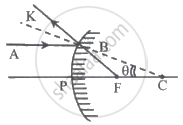Advertisements
Advertisements
Question
Answer the following question in detail.
What is the limitation in increasing the magnifying powers of a simple microscope?
Solution
In the case of a simple microscope,
Mmax = `"D"/"u"=1+"D"/"f"`
Thus, the limitation in increasing the magnifying power is determined by the value of focal length and the closeness with which the lens can be held near the eye.
APPEARS IN
RELATED QUESTIONS
Answer the following question in detail.
How does magnifying power differ from linear or lateral magnification?
Answer the following question in detail.
Obtain the expressions for magnifying power and the length of an astronomical telescope under normal adjustments.
Answer the following question in detail.
What is the limitation in increasing the magnifying powers of a compound microscope?
Answer the following question in detail.
What is the limitation in increasing the magnifying powers of the astronomical telescope?
Discuss about simple microscope and obtain the equations for magnification for near point focusing and normal focusing.
What is the near point focusing?
What is myopia?
What is the remedy of myopia?
What is the remedy of hypermetropia?
What is presbyopia?
What is astigmatism? What is its remedy?
Mention different parts of the spectrometer.
A compound microscope has a magnification of 30. The focal length of eye piece is 5 cm. Assuming the final image to be at least distance of distinct vision, find the magnification produced by the objective.
The near point and the far point for a person are 50 cm and 500 cm, respectively. Calculate the power of the lens the person should wear to read a book held in hand at 25 cm. What maximum distance is clearly visible for the person with this lens on the eye?
A light wave of wavelength λ is incident on a slit of width d. The resulting diffraction pattern is observed on a screen at a distance D. If linear width of the principal maxima is equal to the width of the slit, then the distance D is
There are four convex lenses L1, L2, L3 and L4 of focal length 2, 4, 6 and 8 cm, respectively. Two of these lenses from a telescope of length 10 cm and magnifying power 4. The objective and eye lenses are respectively
When a convex lens of 12.5 cm focal length is used as a magnifying glass, normal eye can see an object clearly at a distance of 25 cm. The magnifying power of the instrument is ____________.
The magnifying power of a telescope is nine. When it is adjusted for parallel rays, the distance between the objective and eyepiece is 20 cm. The focal length of objective and eyepiece are respectively.
The magnifying power of a telescope is high if its objective and eyepiece have respectively ______.
Magnification produced by astronomical telescope for normal adjustment is 10 and length of telescope is 1.1 m. The magnification when the image is formed at least distance of distinct vision (D = 25 cm) is ______.
In the adjoining figure, AB represents the incident ray, and BK is the reflected ray. If angle BCF = θ, then ∠BFP is given by ______.

